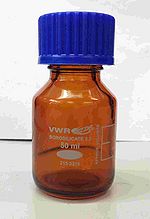Specific Process Knowledge/Lithography/EBL/EBLresist
E-beam resists in the cleanroom
We recommend all groups or users to have their own bottle of e-beam resist inside the cleanroom.
- Find a blue-capped glass bottle in the cupboard next to office 055 in 346 (outside the cleanroom).
- Bring the bottle inside gowning; clean it thoroughly on the outside with water or alcohol
- Bring the bottle to a fumehood inside the cleanroom; clean the bottle and the lid thoroughly on the inside with the main solvent of your resist. For CSAR, ZEP, mr EBL, and most PMMAs, it is anisole. If in doubt which solvent your e-beam resist contains, read the MSDS of the resist to be found here.
- If you need to dilute the resist, find a measurement beaker and clean it thoroughly in same solvent as your own bottle. For CSAR, ZEP, mr EBL, and anisole-based PMMA, you can use the measurement beaker in the box inside the fumehood in E-4.
- Let the bottle dry in the fumehood.
- Bring the (main) bottle of resist to the fumehood. Carefully unscrew the lid of the resist bottle. If necessary, wipe the thread of the resist bottle before you pour resist into your own bottle; dried resists may sit on the thread and be transferred into your bottle (or worse into the large resist bottle) when pouring.
- Clean all bottles on the outside with acetone or IPA, let them fume off in the fumehood. Clean the measurement beaker as well.
- Find a label to your resist bottle; bottles without labels will be removed from the cleanroom.
- Write name, Lotnumber, group and date on your bottle.
When spin coating e-beam resist, you should use a pipette to transfer resist from your bottle to the substrate. If you pour the resist directly from your bottle, you will leave resist in the thread that will soon dry out and leave particles in the resist.
The disposable pipettes need to be thoroughly cleaned with a N2 gun before use (app. 20 s). After some practice, you can obtain particle-free 4" wafers if bottle and pipette (and spin coater) are properly cleaned.
Keep your resist bottles in up-right position, do not tilt or shake them too much, this can spread particles from the sidewall into the resist.
E-beam resists and Process flow
The table describes the e-beam resist used in the cleanroom for standard e-beam exposure. Some of resists are not provided by DTU Nanolab and some are not yet approved for common use in the cleanroom and are currently being tested. If you wish to test some of these resists or other resists, please contact Lithography.
Standard DTU Nanolab resists purchased and tested by DTU Nanolab:
| Resist | Polarity | Manufacturer | Comments | Technical reports | Spin Coater | Thinner | Developer | Rinse | Remover | Process flows (in docx-format) |
| CSAR | Positive | AllResist | Standard positive resist, very similar to ZEP520. | Allresist_CSAR62_English.pdf,, CSAR_62_Abstract_Allresist.pdf | See table here | Anisole | AR-600-546, AR-600-548, N50, MIBK:IPA | IPA | AR-600-71, 1165 Remover | Process Flow CSAR.docx Process Flow CSAR with ESPACER Process Flow CSAR with Al Process Flow LOR5A with CSAR
|
| ZEP520A (not supplied by Nanolab anymore) | Positive resist, contact Lithography if you plan to use this resist | ZEON | Positive resist | ZEP520A.pdf, ZEP520A spin curves on SSE Spinner | See table here | Anisole | ZED-N50/Hexyl Acetate,n-amyl acetate, oxylene. JJAP-51-06FC05.pdf, JVB001037.pdf | IPA | acetone/1165 | Process_Flow_ZEP.docx
|
| Copolymer AR-P 617 | Positive | AllResist | Approved, not tested yet. Used for trilayer (PE-free) resist-stack or double-layer lift-off resist stack. Please contact Lithography for information. | AR_P617.pdf | See table here | PGME | AR 600-55, MIBK:IPA | acetone/1165 | Trilayer stack: Process_Flow_Trilayer_Ebeam_Resist.docx | |
| mr EBL 6000.1 | Negative | MicroResist | Standard negative resist | mrEBL6000 processing Guidelines.pdf | See table here | Anisole | mr DEV | IPA | mr REM | Process_Flow_mrEBL6000.docx
|
| HSQ (XR-1541) | Negative | DOW Corning | Approved. Standard negative resist | HSQ Dow Corning, MSDS HSQ | See table here | TMAH, AZ400K:H2O | H2O | process flow HSQ | ||
| AR-N 8200 | Negative | AllResist | Both e-beam and DUV sensitive resist. Currently being tested, contact Thomas Pedersen for information. | AR 300-47 | H2O | |||||
| AR-N 7520 | Negative | AllResist | Both e-beam, DUV and UV-sensitive resist. Currently being tested, contact Peixiong Shi for information. | AR-N7500-7520.pdf | See table here | PGMEA | AR 300-47, TMAH | H2O |
|
Non-standard DTU Nanolab resists not purchased by DTU Nanolab:
| Resist | Polarity | Manufacturer | Comments | Technical reports | Spinner | Thinner | Developer | Rinse | Remover | Process flows (in docx-format) |
| PMMA | Positive | AllResist | We have various types of PMMA in the cleanroom. Please contact Lithography for information. | See table here | Anisole | MIBK:IPA (1:3), IPA:H2O | IPA | acetone/1165/Pirahna |
| |
| ZEP7000 | Positive | ZEON | Not approved. Low dose to clear, can be used for trilayer (PEC-free) resist-stack. Please contact Lithography for information. | ZEP7000.pdf | See table here | Anisole | ZED-500/Hexyl Acetate,n-amyl acetate, oxylene. | IPA | acetone/1165 | Trilayer stack: Process_Flow_Trilayer_Ebeam_Resist.docx |
| AR-N 7500.18 | Negative | AllResist | Both e-beam, DUV and UV-sensitive resist. Currently being tested, contact Thomas Pedersen for information. | ARN7500.pdf | See table here | PGMEA | MIF726 | H2O |
If the resist is not adhering properly to the substrate, the coating looks like full of pinholes and the edge is not covered, try to remove the resist, dip 30s. in BHF, rinse 5 mins and spin dry, the spin coat again.
